#scourge is literally an anti-hero. it's in the name
Explore tagged Tumblr posts
Text
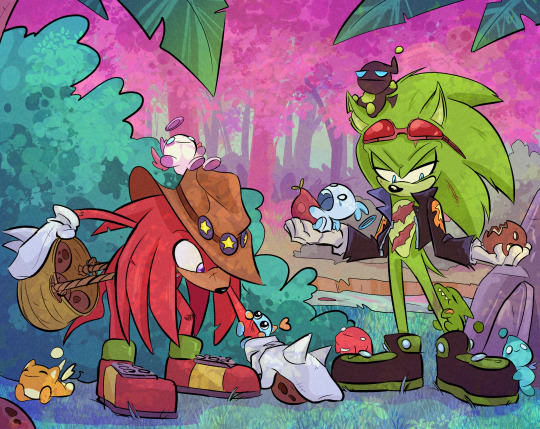
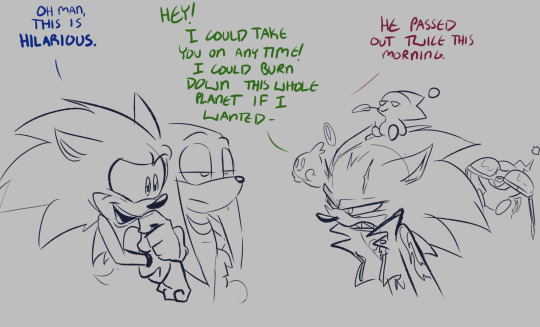
New headcannon
Scourge and Knuckles never meet in the comics, even though he used the Master Emerald to get a power boost, leading to a permanent mutation, etc etc.
So at some point after the prison break, Scourge is living on Mobius since his old team has taken over the anti-dimension,
The M.E has judged him for using it's power recklessly, so he is constantly "leaking" chaos energy, and it's slowly tearing his body apart. Sometimes it gets too overwhelming and causes his scars to reopen. He ends up going to Knuckles to return the excess energy. And although, it doesn't stop the problem 100%, but they've made a monthly routine out of it.
They're not friends, but now he hates Knuckles the least. The chao seem to have taken a liking to him though.But is it because of the chaos energy? Or because maybe deep down he has the potential to be a decent person?
#not a ship#sonic#sth#my stuff#scourge the hedgehog#knuckles the echidna#my favorite character trait is redemption#scourge is literally an anti-hero. it's in the name#let him save the world even if he's complaining the whole time about it
730 notes
·
View notes
Text
Why does the Cuban Embargo exist?
I’ve seen people asking this question due to the amazing vaccine Cuba managed to produce despite it, and there’s a lot that goes into the reasons for the Cuban embargo.
The story basically starts with colonialism and imperialism. The poet and warrior Jose Marti is a Cuban hero for fighting against Spain to win Cuban independence. Unfortunately, that didn’t end the scourge of colonialism in Cuba. You see, Spain had given huuuuge tracts of land as plantations to certain rich loyal subjects. And so the poverty of the general populace continued largely as it had under colonialism.
The United States helped Cuba win independence, but it was low-key a land grab. Walt Whitman, famous American poet, dreamt that Cuba would become a US state. But Cuba didn’t want to become a state, which is where imperialism comes in.
Ultimately, Cuba became a playground for the rich and famous and the American mafia. Resources were owned by American corporations. Land was still owned by colonizers. The “president” was a man who lost an election and then came in from Florida and orchestrated a coup, and he upheld American interests because hm, I wonder why. *eyeroll* It was a military dictatorship, one installed by the US, basically a puppet.
And this environment gave birth to Fidel Castro, who famously failed at his attempt to overthrow the government the first time and was exiled. He met Che Guevara (The Motorcycle Diaries is a fab movie if you want deets there), an Argentinian doctor who may have grown up wealthy but despised the poverty in Central and South America. They had similar ideals. Notably, those ideals were specifically anti-imperialist.
As you might imagine, this didn’t make them popular with the imperialist United States.
But they won. They took the nation, starting in Santiago de Cuba and driving the imperialist forces from the island.
Folks expected that it would just be business as usual. That Fidel and his cohort would just adhere to colonialism/imperialism and be excited to get money.
Nope.
They started nationalizing industries. Kicking out the imperialists. Then they passed an agrarian act, which finally took the land from the old colonizer families that still held it, with the goal of having that land be for the people.
The US, obviously, was not happy with this. How could Cuba be a playground for organized crime and the rich and famous if the status quo wasn’t maintained? How dare!
It turned into a tit-for-tat. The US retaliated against Cuban reforms via trade, and Cuba responded by kicking out more imperialists and taking back their oil production lol.
And then the US cut its sugar quota. You see, once upon a time, most of our sugar came from Cuba. This was a fuckton of sugar. And that could break an economy.
Except the USSR stepped in and picked up the sugar quota. And so Cuba became a pawn in the Cold War.
Mind, we also didn’t like that they fought against apartheid in South Africa, sending aid to the struggle, and fought against imperialism across South and Central America. Famously, Che Guevara was executed and his body desecrated in Bolivia. They eventually sent his hands back to Cuba, and the CIA has his belongings on display like trophies.
The tit-for-tat ended with the Embargo, but the US didn’t stop there.
In 1996, the US passed the Helms-Burton Act, which strengthened the embargo and claimed that (at that point nearly 40 years later) the colonizer-descended families still owned the land that had been redistributed by the Cuban agrarian reforms. Furthermore, if any company in the world was discovered to be using land or resources claimed in Cuba under this act, "trafficking" in property supposedly owned by US citizens (because Cuba is a commodity, not a nation, you see), they would be penalized. This also covers property owned by Cubans who left and became US citizens.
The Helms-Burton Act is still in place, in 2021.
I’m admittedly biased. I’m a US citizen born and raised, but I am anti-imperialist and lean strongly toward socialism. I was able to study abroad in Cuba during a brief window in 2004 when educational programs were permitted to travel to Cuba (directly from Miami, even!).
We traveled the reverse path of the Revolution (Havana to Santiago de Cuba), and studied at the Agrarian University of Havana. At that university, while speaking to students, we noticed one of the buildings was unfinished and had been left to molder. We asked why, and learned that the USSR had been building it, but then the USSR fell and Cuba entered the Special Period, wherein they had to learn how to survive without subsidies from the USSR, with the embargo still in place.
The Special Period was the period of boat people, where people across Cuba were literally starving to death. And the US saw it as just in the name of imperialism, while also trying to gaslight Cuba. Of course, the US picked up the boat people, and there’s even a law that gives any Cuban who steps on US land citizenship. It’s all part of the abuse.
Despite this, Cuba has discovered many life-saving drugs it tends to refuse to patent, preferring to make them available to the world. Cuba has renowned programs to train doctors, and sends doctors world-wide.
TLDR; Cuba is anti-imperialist and the embargo is a 70-ish year-long punishment.
68 notes
·
View notes
Photo


So while Scourge is having a fricking crisis as friends and allies from his past keep appearing, here’s the Anti-Mobius versions of other comic/cartoon-exclusive characters, namely Geoffrey St. John and King Max.
Though its odd that they, like the Anti-Freedom Fighters changed their names to be “different” and “cool” when compared to the main heroes, I’m not sure why Geoffrey and King Max have such different, cool-sounding names, though? Maybe that’s literally just their names.
#RHSB post#SU29#His fricking HAIR#Geoffrey St. John#King Max#Scourge#Ian Flynn#Tracy Yardley!#Archie comics
54 notes
·
View notes
Text
Vae Victis! – A Look Back at Blood Omen: Legacy of Kain
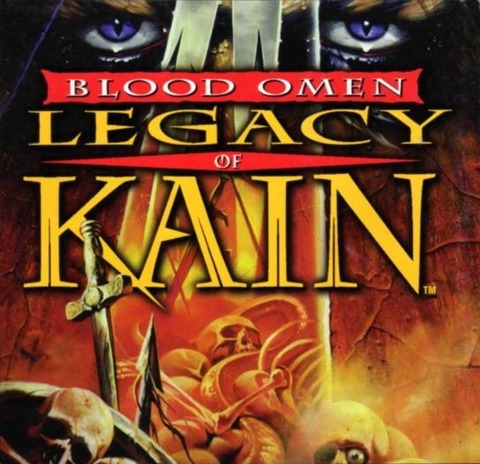
It was the mid-1990s. We were in the fifth generation of video game consoles, and gaming as a medium was eager to prove that it had grown up.
This had been going on before the fifth generation, of course. The Sega Genesis sold itself on its contrast to the status quo. “Sega does what Nintendon’t,” and all that. Sega’s whole image was bound up in being the cool kid, the one who’d outgrown all those pokey “kiddie” games like Super Mario Bros. or Kid Icarus or Mega Man. Sega fans played games like Mortal Kombat and Eternal Champions. Even a mascot game like Sonic the Hedgehog had a kind of snide adolescent streak to it; leaner, meaner, and less patient. Nintendo themselves had to butch up a little, even. When their bloodless version of the first Mortal Kombat got outsold by Sega’s, which kept all the gore – despite otherwise being technically superior in every measurable way – they relaxed their standards and left all the blood and fatalities intact for the second and third games, and saw a jump in sales accordingly.
The 90s were in part a decade of cynicism and ironic detachment. Sincerity tended to be frowned upon as being kind of silly and naive, or else a cover for motives less savory. Strong skepticism was the default mode, and in fiction, anti-heroes were all the rage.
Which brings us to Blood Omen: Legacy of Kain, described by its developers as a Legend of Zelda “for adults”.
Of course, any self-described adult who can’t bear to play a Legend of Zelda game because they feel it’s not grown-up enough needs to sit down and re-assess their idea of adulthood, and how secure they are in it. If a tolerance for violence (if not a craving) is all it takes, then I was an adult at about eleven, when I was single-handedly mowing down whole armies of Nazis in Wolfenstein 3D.
But those were the times, and that’s how Blood Omen got pushed. Which is unfortunate, because it misses the more thoughtful parts of the game’s story that actually did make it material mostly for adults.
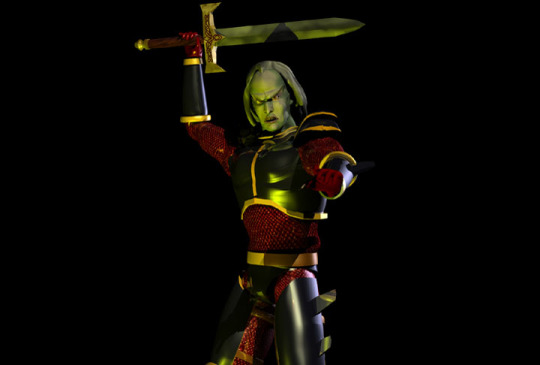
“...the first act in my theatre of Grand Guignol!”
We begin in the world of Nosgoth, and if there’s a made-up fantasy word that screams “dark supernatural fantasy” more than that, I haven’t heard it. Our main character is Kain, a nobleman caught out at night in a town where he can’t find an inn or tavern to stay for the night. He is cornered by assassins and murdered, whereupon he goes to hell. Or at least, we can assume it’s hell; I don’t think even a death metal band’s idea of heaven involves being cuffed to twin posts overlooking a literal lake of fire with a sword stuck through you. Anyway, that’s where Kain is, cursing the fact that he can’t get revenge. Which seems a little warped, on the surface of things. You’d think if you were stuck in hell, then getting out, however impossible, might seem more important than getting back at the people who killed you. But if you’re the kind of person who winds up in hell after being murdered, I suppose it stands to reason that your priorities may not be in order.
While Kain is in hell, lamenting his impotent rage and generally ignoring all the fine mid-90s CG scenery, he is approached by a necromancer named Mortanius.
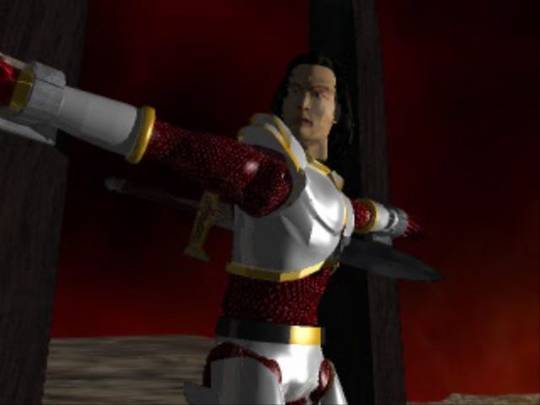
The necromancer offers him a way back to the world of the living, and thus a chance at revenge. Eager to oblige his overdeveloped sense of wrath, Kain takes him up on the offer, and fails to consider that there are only a few different ways, traditionally, that a dead person can cross back through the veil. And none of them really involve returning to life exactly as you were.
Kain rises from his grave as a vampire, stronger than he ever was in life, and only too happy to hack up his assassins when he encounters them not far from the site of his crypt. However, as he comes down from his vengeance-high, he hears a voice in the back of his mind – Mortanius’s voice, in fact – suggesting that his assassins were “the instruments of your murder, not the cause”. Mortanius then urges him to seek out the Pillars to find the real reason for his murder, and its true culprits.
We need to rewind a bit.

IN THE BEGINNING, there were the Pillars of Nosgoth (in fact, “Pillars of Nosgoth” was the game’s working title for a while). Rooted who knows how deep in the earth below, and reaching up to the clouds, the Pillars are a structure that should be physically impossible. They are somehow both integral to the natural order of the world, and also the embodiment of certain elemental principles. There are nine of them, embodying – in no particular order – conflict, energy, states (of being, not political), dimensions, death, nature, time, the mind, and balance. Each Pillar has its guardian, a human endowed with powers according to the Pillar’s defining principle, and tasked with overseeing that Pillar’s particular province.
A good while back in the past (how long is not detailed in this game, but probably centuries) there was a genocidal crusade of sorts against vampires, who were evidently a serious scourge of some kind. In fact, the game opens on a view of a field – practically a forest – of stakes, with a vampire impaled on each. Vlad Tepes would be proud. This crusade was ordered by the Circle of Nine (the collective group of Pillar guardians), and carried out by the fanatical religious order known as the Sarafan Brotherhood.
Monsters that they are, the vampires did not take this well. One of their number, an elder vampire named Vorador, decided to strike back. Vorador was by this point in his unlife no longer quite human looking, with mottled grey skin (later series installments would make this varying shades of green), odd three-clawed hands, and giant bat-like ears. Blood Omen never elaborates on the reason for this difference. At any rate, he singlehandedly stormed the citadel of the Pillar guardians while most of the Sarafan brotherhood were away (presumably looking for more vampires to stake), and wound up killing several of them (one of the sequels gives the number as six). In the process, he even managed to beat down Malek on his way out, perhaps the greatest warrior among the Sarafan, and the one specifically tasked with safeguarding the Circle.
For screwing up his one job, Malek was punished by being made to do that job for eternity. It might seem inadvisable to take the guy who failed to guard you and then make him your guard forever, but it helps if you rip his soul out of his body and bind it to his armor, thus making him a sleepless, tireless, unfeeling, and ever vigilant warrior fueled by pure wrath. Which is what they (or rather, Mortanius) ultimately did. At some point between this time and the present day of Blood Omen, Malek became the guardian of the Pillar of Conflict, so evidently he was fit for his role in the end.
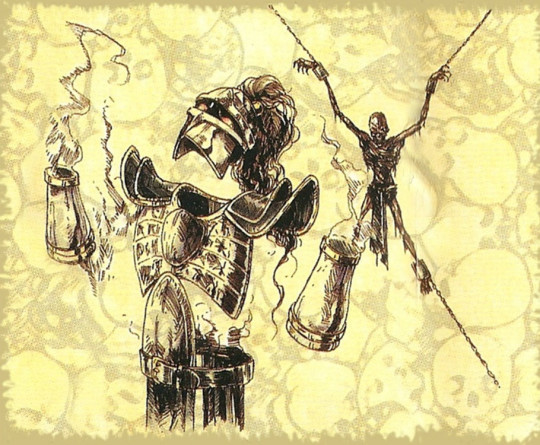
Now we fast-forward a bit, to a point just moments before Kain’s birth. In fact, later games place this at the exact moment of that birth.
Somewhere around thirty years before Kain’s murder outside a nameless tavern in a random town, Ariel, the guardian of the Pillar of Balance, is murdered. This is bad news for all the usual reasons, and also one or two unusual ones. It turns out that her lover is the guardian of the Pillar of the Mind, the mentalist Nupraptor. Her murder drives him insane, and being a telepath (among other things), his insanity infects the guardians of the other Pillars as well. This turns them from their usual purpose of upholding the natural balance, and instead sets them to destroying it. This in turn corrupts the Pillars, symbiotically connected to their guardians, turning them from pristine white to a pitted and cracking grey. With both the Pillars and their guardians respectively corrupted and insane, the natural order of things begins to fall apart. Bad news all around.
Blood Omen is somewhat unusual in that it’s one of the few probably rare instances in fiction where a woman is stuffed into the fridge at the beginning of the story, and in order to drive the villain to extremes of behavior.
So.
Now we have Kain, in the present of our story, given to understand that his death was in some way connected with the Pillars and their corruption. He makes his way to the Pillars, where he meets Ariel’s restless spirit. She’s the one who lays out for him part of the business about her murder and Nupraptor’s madness, and the threat posed to the world by it all. Kain is only interested in a cure for his vampirism (now that he’s had his vengeance, he wants no part of this undeath business), but Ariel persuades him that his best bet is to deal with the corruption of the Pillars. So Kain storms off to go take care of Nupraptor, and ultimately to cleanse the Pillars by severing their connection to their now-insane guardians, solving the problem of their corruption by reference to his sword. Go with what you know.
It’s at this point that Kain’s personal arc begins to unfold, as he becomes increasingly alienated from humanity, both the species and the concept. While initially at odds with his vampirism, Kain spends the story coming to grips with the hypocrisy and corruption of human civilization, all the while becoming more and more comfortable with the seeming monstrosity of his new existence. This is a matter of some necessity. He has things he needs to do, he has to stay alive to do them, and so a certain amount of blood-drinking and slaughter seems inevitable.
In his travels, he comes across Vorador’s manor, situated deep in a swamp teeming with monsters. Kain seeks his help to destroy Malek. Vorador, for his part, spends the encounter being lordly and largely dismissive of Kain’s quest. He advises the fledgling vampire that meddling in mortal affairs is nothing but bad news. Better to sit back and sate one’s hunger – or thirst, in this case – and let the mortal world turn as it will. Humans are to be preyed on, not helped or manipulated or otherwise gotten involved with. Best to stay above such passing concerns. Nevertheless, he takes a liking to Kain, and gives him his ring to summon him at need.
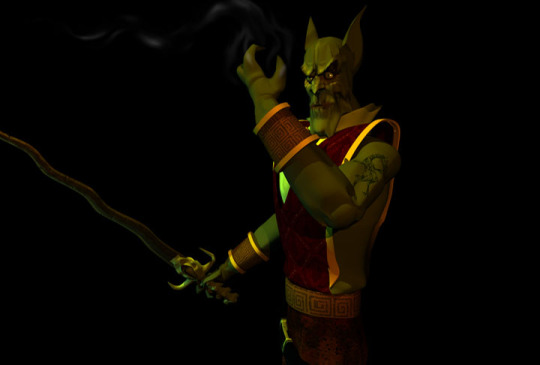
Say a word often enough, and it starts to lose its sense of meaning. Actions likewise lose significance with repetition. They become rote. And as time wears on, Kain seems to begin making a turn. There’s a certain honesty in being a monster. You always know what you are, and you always know how other people see you. Kain may sneer at Vorador’s decadence when they meet, but at least the elder vampire is never less than one hundred percent honest about what he is.
And as Kain goes on, it begins to seem that Vorador was right. So much of Kain’s and the world’s difficulties seem to stem from the selfishness, greed, shortsightedness, self-absorption, and general malice of the people he runs up against. Eventually, he winds up accidentally sparking a second genocidal crusade against his own kind. This has mostly to do with him traveling back in time to kill a man in the past who would grow to become a tyrant in his current era. This mistake no doubt has its roots in his not having not grown up in a world with a whole sub-genre of fiction concerned with the merits or otherwise of traveling back in time to kill Hitler.
We will have such fun with time travel as the series goes on, let me tell you.
The game ends by offering the player a choice. Kain’s efforts to cleanse the Pillars and restore balance to the world have made him the new guardian of the Pillar of Balance. Yet, like all other Pillar Guardians slain at his hand, he himself is corrupt, and must die to complete the task. So the player is asked: Will Kain willingly sacrifice himself for the greater good of Nosgoth, or will he refuse the sacrifice and choose to live in an increasingly broken and corrupt world.
The sequels take the second ending as canon, and honestly, it’s hard to argue. This isn’t a story about hope springing eternal, after all. The few people in it who are unambiguously good are either killed (Ariel) or largely ineffectual (King Ottmar, who comes to prominence briefly toward the end of the story). The player may feel differently, but there’s little reason to believe that Kain would. Proud, haughty, vindictive, wrathful, and growing ever more cynical and mistrustful of the motives of those around him, tired of being used as a tool for other’s schemes... Why would he choose to sacrifice himself?
And so, canonically, we close on a shot of Kain sitting on a throne at the base of the Pillar of Balance, with it and all the other Pillars lying in a broken ruin around him. He drinks from a goblet, and muses that Vorador was right after all: “Vampires are gods – dark gods – and it is our duty to thin the herd.”
The End.
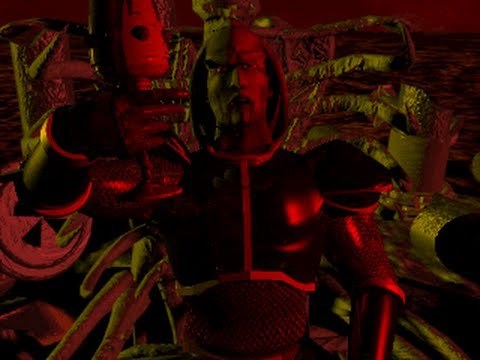
“Nothing is free. Not even revenge.”
So that’s Blood Omen as a story. What about as a game?
On the balance it’s kind of uneven.
On a technical level, it’s fairly impressive. In its time, it stood as a testament to the potential quality of two-dimensional graphics in gaming, even as the entire medium was leaping into the third dimension, ready to ditch and decry anything made in 2D as inferior. The result from a technical standpoint is that Blood Omen has in some ways aged better than a lot of other games of its vintage, including its first sequel.
But then you actually play the thing, and see where it sort of falls apart.
Let’s get the easy part over with, shall we? The load times in Blood Omen are godawful, just the worst possible combination of long and frequent. It seems almost like a joke at times: “Really? We’re loading again? It was one fucking room!” Were it not for the fact that it began development as a totally unrelated game, I would strongly suspect that the sequel, Legacy of Kain: Soul Reaver, used its data-streaming technology to avoid loading times altogether purely as a response to this criticism. I still think that may be the case.
Once we dig past the issue of loading times, though, the game reveals other issues.
There are good ideas on display here. Let’s start with that. The game has a day-and-night cycle, and while you can walk around during the day, you deal less damage (and take more) while the sun is up. Water is like the touch of acid to a vampire, and any time you’re in it, you’ll take constant damage. Rain and snow will likewise damage you, and while there are power-ups that are supposed to eliminate this problem, I’m not sure they actually work. At least, not on the PC version of the game, which is what I’ve mostly played.
The game also requires that Kain drink blood periodically. His health naturally drains very slowly, but constantly, so you always have to be on the lookout for a way to top yourself off. There are some more abstract health restoration items, as well as a consumable item you can use, called the Heart of Darkness (this item will become obscenely important in later installments). However, the game is structured such that most of Kain’s health restoration will have to come from either enemies or, more often, helpless innocents. This ties nicely into the game’s theme of alienation from humanity, though the way the game often presents these situations –random strangers chained to walls all over the world, for no apparent reason – seems a little odd at times. And it has interesting ideas about different creatures having blood that might actually be harmful to Kain, or inflict him with a long-term poison.
In addition to the graphics looking nice (the CG cutscenes are definitely of their time, but the in-game sprite work and lighting effects are quite nice), the game has a great soundtrack, dark and moody and ominous. And the voice work is superb. All character interactions are handled with voiceover rather than on-screen text, and the cast knocks it out of the park. Not just “good for the mid-90s video game voice acting”, but great, period.
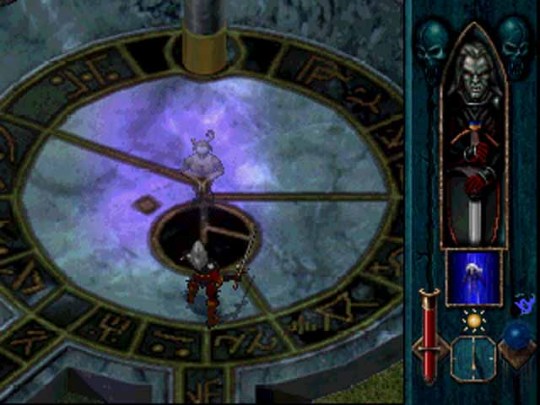
The puzzle-solving is a little lackluster, though. For something pitched as a “grown-up Legend of Zelda”, its puzzles largely consist of pulling levers and pushing buttons, and navigating mazes. Which is fine, but again, any game that’s going to self-consciously compare itself to The Legend of Zelda needs to bring its A game, especially with its puzzle-solving.
The game does offer you a lot of tools to use, in the form of different weapons, spells, and magical items. But a lot of these boil down to more inventive yet questionably practical ways to kill enemies. And considering that setting up a selection of these items for immediate access involves going back and forth to the inventory menu (requiring a load time both ways), it’s easier to just stick with your weapon and a handful of the most commonly used spells and items and call it a day.
Weapons themselves are another problem. You’ll find that your iron sword from the very beginning of the game is the most generally useful. The mace will let you stun human enemies to drink their blood after just two hits, but it lacks the crowd-control effect of the sword, and also lacks the stunning effect on the non-human enemies that make up the bulk of your later-game foes. It’s also useful for knocking down certain stone barriers, but these are few and far between, and necessary for progress only very rarely. The twin axes let Kain cut down trees barring his path, and also let him cut down enemies by spinning like a saw blade… but this means you’ll frequently kill enemies before you have a chance to drain them. The flaming sword burns enemies alive and leaves only ashes, preventing you from drinking blood that way. And then the final weapon, the Soul Reaver (also an item of incalculable importance later in the series), deals massive damage as long as you have magic power to fuel it. But while thus empowered, it detonates the enemies it kills, making them impossible to drain. And when not empowered, it’s only as damaging as the iron sword, but slower and more awkward.
Combat in general gets frustrating at times, thanks to the iffy hit detection. One enemy might walk right through your sword swing, while another you could swear was out of range will register a hit. It never becomes a total deal-breaker, but it’s a point of frequent irritation as you go.
Let’s have another positive: Kain also gains the ability to transform into various other states as the game goes by. In his wolf form, he can leap over certain obstacles, but his attack in this form has no combo ability and a long wind-up, making him vulnerable. He can use his bat form to fast-travel between beacons and certain landmark locations, while his mist form allows him to walk on water without taking damage, as well as cross certain barriers without opening the door. There are also two disguises he can use. One transforms him into a peasant, while the other turns him into a human-looking version of himself so that he can pass as a nobleman. The use of both of these is largely situational, required in a very small number of situations and then mostly pointless outside of them.
But perhaps the thing that stands out the most is its linearity.

This is to some extent mandated by the story. Unlike The Legend of Zelda, to which this game invites much comparison, Blood Omen’s story is very much at all times front and center. A Zelda game will leave you with bits of story here and there, and largely leave you to explore or puzzle your way forward or dick around in town or otherwise do your own thing for long stretches of time. The story in one of those games is the starting point of the experience, a backdrop against which you play out the adventure. Hyrule is to some extent defined by that openness, with its plains and deserts and vast forests and so on.
Blood Omen lacks this. Its story is the entire point and purpose of the game. The path forward is always clear and rarely has room for deviation or discovery. There may be things hidden off to the side, but these tend ultimately to be cul-de-sacs, connecting to nothing else. This is even subtly expressed in the game’s environments: lots of indoor areas, caves, narrow trails, canyons, and so on. There’s little opportunity to go off the beaten path. Blood Omen’s pathways not only discourage exploration, they often disable it. This is not your experience to own; it is Kain’s story for you to be told.
I feel like in story terms, that’s ultimately the difference. Legend of Zelda’s story always exists to serve the game that Nintendo crafts. Blood Omen: Legacy of Kain’s game exists to serve the story.
And just to be clear, none of this is bad at all. It’s every bit as valid in terms of game design and mechanics as any given Zelda. But if you’re going to compare your game to The Legend of Zelda and then fail to do the most essentially Zelda things in it – not just do them poorly, but not do them at all, missing the point entirely of what a Zelda game is about – then it’s worth commenting on. I like Blood Omen, but I had to get used to thinking of it on its own terms. The Zelda comparisons are easy to make. Even without the developers making them, the look and structure of the game seems to invite them.
Like a good book, Blood Omen is a (mostly) straight shot from start to finish. Its linearity is what allows it to control the story, to unfold its plot and explore its themes at a pace of its choosing. The game to some extent revels in its edginess, but to be honest, it was perfect for me at the time. I was sixteen when I first played the game. Sixteen, and a bit of a loner with an odd and private (but intense) interest in vampires. It was probably the perfect game for me at the time. And it’s still ultimately enjoyable today, if you take it as what it is. Not as a Legend of Zelda game for adults, but as a decent action-adventure game with a good story and top-notch presentation. If you don’t mind the linearity and the relentlessly dark and sometimes disturbing story, it’s just about perfect.

Post-script the First: Likelihood of Re-release, and Current Availability
Eeeehhhhhhhhhh...
Here’s the problem: Blood Omen: Legacy of Kain was originally dreamed up and created by Silicon Knights and published by Crystal Dynamics (who also had a hand in the development, late in the process), with distribution to be handled by Activision. Crystal Dynamics eventually got full ownership of the Legacy of Kain brand, and used it to make the first sequel to Blood Omen, titled Legacy of Kain: Soul Reaver. Silicon Knights was against this, but had less deep pockets than Crystal Dynamics, so they were ultimately the losers of the resulting court battle over the affair. The lone bone thrown to them was that Crystal Dynamics had to acknowledge in the game that Soul Reaver was based on characters and ideas created by Silicon Knights.
By the time Soul Reaver rolled around, Crystal Dynamics belonged to Eidos. Then, in 2005 (not long after the last Legacy of Kain game was published), Eidos was completely bought out by Square Enix, and was mostly refocused on creating western-style games under the Square Enix umbrella. Crystal Dynamics still exists as a division within Square, where they’ve been making various Tomb Raider games almost exclusively ever since the acquisition.
The problem with any hypothetical remaster or re-release of Blood Omen: Legacy of Kain is that, for several years, it would have required some three-way legal wrangling to determine who really owned the thing, and what they could do with it (if anything), and under what conditions.
As of about 2014, Silicon Knights ceased to exist (about which more later, because it’s a fun story), but that still leaves the rights an open issue. Square Enix seems to own the larger Legacy of Kain intellectual property, but there’s the question of ownership regarding Blood Omen: Legacy of Kain specifically, and I’m not sure that question has ever been answered. Silicon Knights doesn’t exist, but many of its personnel are still around in some capacity, and would presumably have something to say about anything involving it.
Venues like Steam and Good Old Games have released the every other installment in the series digitally (even Blood Omen 2), but nobody’s touched the original game. Probably CD Projekt Red and Valve don’t have much desire to try unsnarling the ownership and licensing issues themselves, and none of the owners seem all that keen on it, either.
And it will probably stay that way. The Legacy of Kain series in general has always been pretty solidly in the B tier of video games, from back when there still even was much of a B tier in the first place. The fanbase for that kind of deliberately overwrought gothic supernatural fantasy was loyal, but never very big, and I’m not sure how much that’s changed. Moreover, I’m not sure either Square is willing to bank on it having grown in the interim enough to do anything about this first game in the series. The more time goes by, the less inclination any party has to make anything of the series, especially an early entry whose ownership may be contested. An indirect sequel, and also some kind of MMO, were both in the works at various points. The MMO vanished after not very long at all on the market, and the indirect sequel never made it out of development.
Legal options for playing Blood Omen: Legacy of Kain are limited. You can play the original PlayStation version on the PlayStation 1, 2, or 3. It’s also digitally available on the PS3, although not for the PSP or Vita. Infuriatingly, it’s one of a small handful of games that can’t even be side-loaded (a process that involves downloading a digital PS1 game onto your PS3, then copying it uninstalled to the Vita). The PC version, meanwhile, can still be played, though there’s a special program custom-made for it that you’ll have to get in order to install it and run it on modern systems. And this tends to run a little slow. Music and sound are fine, it’s just the game actually moves slower than normal. Or you could install a virtual desktop and play it that way.
Post-script the Second: The Death of Chivalry
So whatever happened with Silicon Knights?
Well, the story is… not complicated, exactly, but not entirely straightforward, either.
Development of Blood Omen was troubled. As we would later learn, this was not an especially novel situation for Silicon Knights to be in. Two of their other big projects later on underwent some turbulence in production. Blood Omen was originally to be created by Silicon Knights and published by Crystal Dynamics. Later on, after Crystal Dynamics became part of British publisher Eidos, they were able to somehow leverage this connection to strongarm their way into ownership of the overall Legacy of Kain intellectual property. They used it to make the first sequel to Blood Omen, titled Legacy of Kain: Soul Reaver. This had begun life as a brand-new IP (originally titled Shifter), which helps explain some of the tremendous thematic, aesthetic, and design differences between the two games.
Silicon Knights later maintained that they’d had their own ideas for a potential Blood Omen sequel, but never got around to it, and after Crystal Dynamics started making their own sequels, Silicon Knights lost interst. I’m not sure how much of that is real and how much is just so much sour grapes. Anyway, they went off and did their own thing for a while. They published the survival horror game Eternal Darkness: Sanity’s Requiem for the GameCube, after having signed an exclusivity deal with Nintendo around that time. It had originally been in development for the N64, but was ultimately moved up to the newer hardware after development delays. For anyone who’s wondering, Eternal Darkness an excellent game, on the shortlist of must-own GameCube titles, even if you’re not necessarily a fan of survival horror. It’s not perfect (among other things, you have to beat the game three times to see the true ending), but it does a lot of interesting things.
They also developed the GameCube remake of Metal Gear Solid (likely under heavy scrutiny and supervision form Konami), dubbed Metal Gear Solid: The Twin Snakes. Much as I tend to prefer the original version of the game for its restraint (Twin Snakes has a lot of ridiculous high-flying wire-fu maneuvering in its action cutscenes), the remake is worth any Metal Gear fan’s time. Among other things, series creator Hideo Kojima has apparently declared it the canon version of events. It also saw a re-dubbing of the entire script, since apparently when the original audio was played back at a higher sampling rate, you could hear the traffic in the background, which the ramshackle soundproofing used in the original hadn’t been able to entirely shut out. The re-dubbed script also has the benefit of having allowing Jennifer Hale and Kim Mai Guest to ditch their put-on accents – Guest’s being particularly irritating, and borderline racist (maybe actually racist; I’m a white dude, and not totally clear on these things).
After this, they moved on to the Xbox 360 with their passion project Too Human, which had been troubled from the beginning. Its on-again, off-again development cycle spanned a decade and three console generations. It began development for the original PlayStation, then shifted to the GameCube when the developer did in the early 2000s. It went quiet for a few years, then resurfaced as an Xbox 360 project that was ultimately delivered in 2008, two years after its projected release on that console.
Too Human was a notorious, news-making flop, and Silicon Knights responded to this failure not simply by pinning the blame on someone else, but by doing that and then actually suing them. Specifically, they sued Epic Games, from whom they had licensed the Unreal Engine 3 to make the final version of Too Human. The accusation was that Epic deliberately sabotaged developers who licensed their engine by providing an incomplete product, and that the difficulties stemming from this had caused development delays. These delays, and the compromises they brought about, were supposedly ultimately responsible for the failure and the financial losses of Too Human.
Epic responded by then counter-suing, which was the beginning of the end for Silicon Knights.
Epic’s counter-suit stated that Unreal Engine 3 was a work in progress, and that they were making it essentially on the fly as they developed the first Gears of War. The counter-suit further stated that it was readily and openly acknowledged that the engine was unfinished, and that when it was done, it might ultimately not turn out to be useful for the licensees. Epic’s suit further indicated that these facts were all known and laid out in the licensing contract, and so like all licensees, Silicon Knights knew this when they signed for it.
But it gets better (which is to say, worse, at least for Silicon Knights). Epic’s counter-suit also included the allegation that Silicon Knights had knowingly and wrongfully copied code wholesale from Unreal Engine 3 and incorporated it into their own engine without permission from Epic. They had then gone on to use this hybrid engine on other internal projects without the permission of the people they’d cannibalized it from.
Now, I’m not one to root for a big corporation, even (especially) a game developer. But Silicon Knights had the misfortune of being run by Denis Dyack, a known con-man, grifter, shady bullshitter, and general ambulatory phallus. He maybe wasn’t in the same category as a Randy Pitchford or a Bobby Kotick, but that’s less a matter of capacity and more a matter of opportunity. Given the chance to operate on their scale, I don’t doubt he’d have fit right in with that crowd.
As far as the court case went, the evidence was overwhelmingly in Epic’s favor. In addition to their own court costs and damages awarded to Epic, Silicon Knights was forced to recall all unsold copies of Too Human and X-Men: Destiny (another game they’d developed with their Unreal Engine 3 hybrid), as well as scrap all projects using the engine, which seems to have been literally everything they had in the works at that point.
So what happened, essentially, is that Silicon Knights sued Epic Games in an effort to offset their losses by making money out of the Too Human debacle somehow, and it backfired so comically that they broke themselves against their opponent.
But their end, one way or another, was probably inevitable in that console generation. Looking at their release history, there’s really nothing that stands out as a hit or an absolute classic. Eternal Darkness and Metal Gear Solid: The Twin Snakes were both fine games, this much is true. But Eternal Darkness was a GameCube exclusive, and the GameCube didn’t sell the way Nintendo hoped. Meanwhile, The Twin Snakes is certainly nice, but as a remake of a different developer’s game, it has little in the way of originality, and very little of the material can really be said to “belong” to Silicon Knights, since it was someone else’s brainchild right from the start.
They were never a hugely prolific publisher, with eight games published before they folded, and according to Wikipedia, seven known titles cancelled at various points during their existence. These cancelled projects included two sequels to Too Human (which had always been planned as a trilogy). Given the cold reception received by the original, both from critics and consumers alike, that seems questionable. In for a penny, in for a pound, I guess. But however you look at it, they didn’t have what you’d call a good ratio of finished to unfinished projects. And while it’s worth mentioning that many of those unfinished projects were upcoming games they were forced to cancel because they’d been made (or begun) with their illegal Unreal Engine 3 hybrid, the fact is that when your business plan hinges on stealing another developer’s game engine to make your own games, you’re already in a bad place.
Silicon Knights pretty firmly slotted into the middle tier of video games. For my money, the middle tier is in some ways the sweet spot. It’s more high-tech and technically involved than the indie set, yet not so high-budget that developers in it can’t feel free to experiment. But that middle tier has all but vanished these days. It’s questionable whether Silicon Knights would have hung on long enough to find a spot in it today, even if they hadn’t destroyed themselves going after Epic, just based on the iffy reception of their games. That’s without considering the general skullduggery it took to keep them going in the first place. And I also tend to think of X-Men: Destiny as a bad sign. There’s no shame in work-for-hire; it’s how a lot of major development studios (like Blizzard) started out. But that’s the key: you start out doing work-for-hire projects to make the money to strike out on your own. Silicon Knights was moving in the opposite direction, and that’s a bad sign.
Vae Victis, indeed.
#legacy of kain#blood omen#blood omen legacy of kain#kain#video games#video gaming#games#gaming#silicon knights#vae victis#halloween
11 notes
·
View notes
Text
ITS THAT TIME OF THE YEAR.
LIBRA MONTH. AND IN HONOR OF THIS- I officially present an- for my smut waifu- TNAngel's birthday:

VIVERS RELATIONSHIP HCS
Now with even cooler 90s font.
For those who don't know of this- please consider joining my 18+ FFXV Discord Server- Scourge's Armiger And Trash Trove. Where we celebrate the chocobros, anti-heroes, ocs and villains! https://discord.gg/CAYqNBG
Now, without further ado- Let's drop some hcs. Please be advised, this is gonna get nsfw. And has a lot of ViVersDyn nudging. Because that's the ot3 tea. I'll also be differentiating 'Orsus AU' and 'Fallen Majesty ver' accordingly.
(Oau) During her time in water stasis, Vers actually joins Vivian in the water while she's asleep during a particularly prophetic dream she's having. It's very soft.
(Oau) When they sleep together, Vivian sometimes wakes to Vers's mouth literally on her tiddy. He can't help it, they're his favorite.
(Oau) After finding out how much Vivian loves moths, he goes about studying them. As he's already a fan of entomology- he later gets her a moth enclosure.
(Oau) When Ardyn is legit giving them both a good 'punishment' diccing, they hold hands if laid by each other.
(Oau) Vers won't let Vivian eat anything preserved from Solheim, as he wants to do science on it. In return, she stuffs plants that emit bitter horomones into his office.
(Oau) Verstael helps Vivian make a proper isopod onesie for their child.
(Oau) Vivian mispronounces things during sex intentionally. Just so Verstael will shut her up with his mouth.
(Oau) When Ardyn won't help and Verstael is doing lab work- Vivian picks up things on higher shelves for him.
(Oau) When the two get into arguements, she raises all the computer chairs in his lab to be higher than the screens.
(Oau) Alternatively, Verstael will intentionally do a lot more hand motions and enunciate in meetings to rile her up.
(Oau) They both get off to hearing each other talk about experiments, even if it isn't their kind of experimentation.
(Oau) Vivian once made her room into a hothouse for the plants. She needed Verstael for an experiment. The ones that relied on human horomones after were MORE than happy.
(Oau) Vivian steals not only his cape and coat, but Ardyn's coat and shawl. When found, she's usually nesting with them to keep warm.
(Oau) Verstael loves being carried by Vivian when tired. She gives him lots of ear kisses and will bring him from the lab to his room.
(Oau) Did it in the clone room as punishment for Vivian acting up.
(Oau) Old Verstael and Old Vivian are a lot softer with each other. It's like watching two really old birds cuddle.
(Oau) Old Verstael and Old Vivian did it in his chair once. It was mind-blowing and thank goodness they had the stoppers on the wheelchair.
(Oau) Vivian does a lot of watercolor of the plants. She sends them to Altissia under the name of 'G. Samaritan' which are brought by Verstael. They're sold to help the people of Altissia recover and because of the materials used (Solheim materials), they're valued at a higher price. The money goes to families and groceries.
(Oau) Vivian and Verstael got high together off Galahdian weed once. They ended up solving 1 of the 6 Clay Mathemetics problems (see below this bullet.)

To cheer Verstael up, Vivian and Ardyn will often tell him stories of Solheim. The two are very theatrical and will argue with each other about what happened or embarrass each other.

(Oau) Vivian sings to Verstael when he's tired. It usually calms him. Doing so to Ardyn- as he is the Scourge- will cause him to sleep comfortably.
(Oau) She dances for Verstael the traditional way. It WRECKS him.
(FM) Verstael looks incredible in feathers for the Aborigine Mage Festival. Though he can't understand why Ardyn gets to be more naked for it than him. (It's because his nips belong to them. Not the Mages.)
(FM) Verstael is who helps Vivian recover the Fallen Majesty blade with Lunafreya's aid. The only other weapon able to kill an Astral and crafted by the First Oracle and Eos.
(FM) During the fight with Noct and Ardyn, it's Verstael who helps Vivian out of the Citadel to stop Noctis from killing Ardyn, using the Vessel. It purges Ardyn of the Starscourge for the final fight.
#ferrero chocobo#vivers#viversdyn#oc vivian wormwood#lemon#birthday gift#tnangel#ardyn lucis caelum#verstael besithia#aera mils fleuret#ocs welcome#scourges armiger and trash trove#ffxv discord#final fantasy 15#final fantasy xv
4 notes
·
View notes
Text
Thoughts on the Chinese DotA Animated Series, The Tower Will Go On, and its two main characters
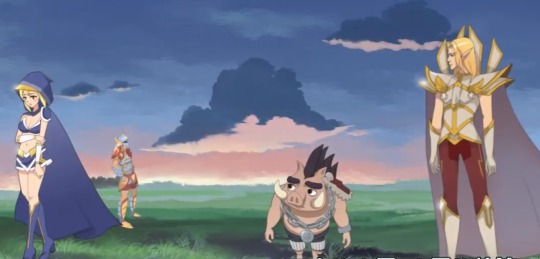
It’s been five years since this animated series based on Warcraft 3 Dota was made. The fan forum is still alive, and it’s amazing to witness the fan dedication to this work, in the form of essays, debates and even a ridiculously detailed second-by-second analysis of the opening theme.
But I barely got a glimpse of those essays before they were removed, apparently to be scrutinized by their internet police for objectionable content. The series itself has also been taken off all China websites, such that China’s fans themselves can’t watch them even if they wanted to revisit. Which makes me so glad that I have all the episodes in HD.
Anyway, on to the show itself. It’s divided into two parts:
Season One is about Crystal Maiden forming her rag-tag team of Radiant/Sentinel heroes. It’s light-hearted and full of jokes. The heroes die a lot and revive at the fountain every time. Sniper’s death count reaches above 300 at one point.
Season Two (titled Death for the Reborn) is darker as the team clashes with the Dire/Scourge and the war intensifies. The plot gets more complicated with internal factions, spying and conspiracies. The rules change: the river that revives dead heroes gets corrupted, so deaths are permanent.
One’s reaction to this show would likely be: “No! This isn’t Dota. This isn’t Invoker at all! What travesty is this?!”
But first, let’s consider these two things:
Firstly, the story is set in the game map. All hero skills and items stay faithful to the game. There is no ‘lore’ to speak of, as this series came out before Valve took over Dota. During that period, ownership of Dota was attributed to Ice Frog, who’s referenced in episode 2.
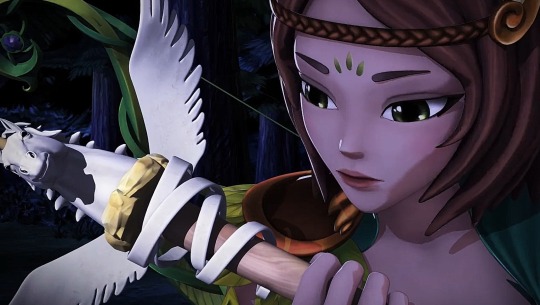
Eul’s Scepter in the show
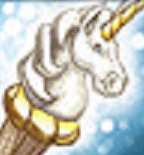
Old Eul’s Scepter in Dota 1
Secondly, it’s fan-made. And as with all fan creations, anything’s possible.
For example,
It’s possible for Bloodseeker to be gay with a jungle creep(centaur) and foster a baby centaur.

Bloodseeker X Jungle Centaur in the show
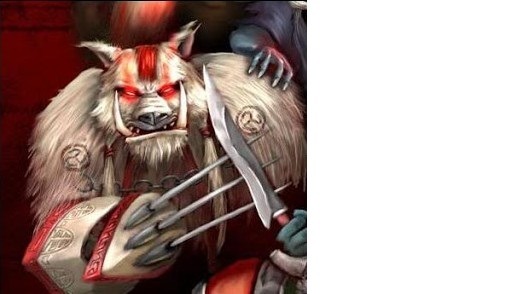
Old Strygwyr in Dota 1
It’s possible for a carry to be so fed, he’s ten times the size of another:
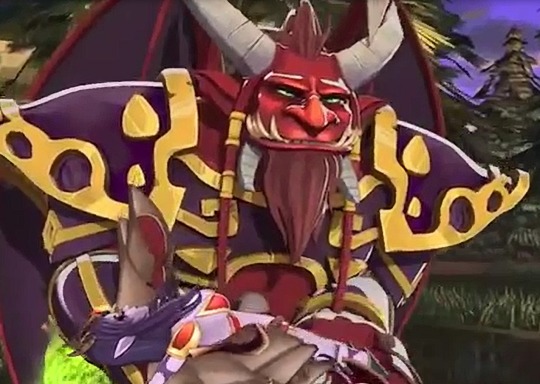
Daddy Doom and his Little QuoP
Love it or hate it, this fan tribute to Dota is in a class of its own. It’s entertained me for hours, made me laugh, sigh, cringe, think; it was one hell of a nostalgic ride back to Warcraft Dota days. And it will always have a special place in my heart.
And now, on to the main characters…

The protagonist - a tribute to Support Heroes
‘Little Ice’ (China’s pet name for Crystal Maiden) is a fan-service kind of character whose appeal is mostly sexual and emotional. I won’t talk much about her but I won’t write her off completely either.
So Little Ice starts off with a dream to rise above her destiny as a position 5 support. She’s left her team carry (Dragon Knight) as she resents him for being overbearing and overly task-oriented. (It’s unclear what’s the relationship between the two, though they hug a couple of times). She tries to carve a career for herself, forming her own rag-tag team. But reality is a wet blanket, and like her role in the game, her impact on the story is limited and she ends up having her heart broken several times.
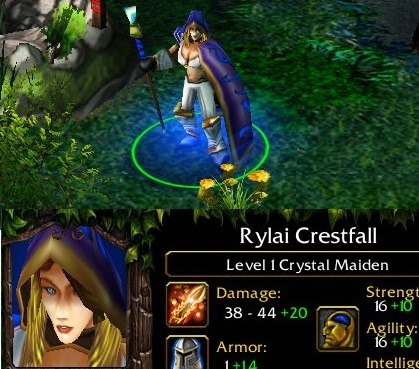
Old Crystal Maiden from Warcraft 3 Dota
In the show, she is depicted as a klutz with a bad sense of direction and is sometimes impulsive, casting Freezing Field at the most ridiculous, anti-climactic moment and generally doing stuff that would be considered ‘bad decision making’ in the game.
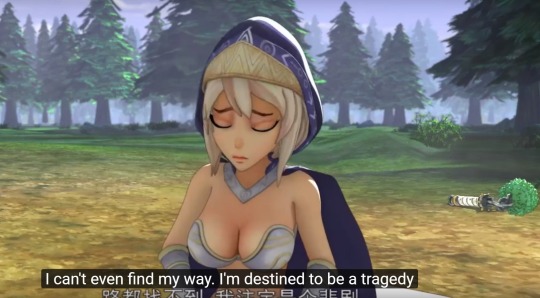
But despite her limitations, the girl has a mind of her own. She stands firm in her beliefs and is courageous enough to try to protect her male teammates. Even when said teammate is the Dragon Knight being bashed up by Roshan.

She is also fiercely loyal, refusing to abandon the dying Bristleback and instead managing to persuade DK to risk a Roshan fight to get the Aegis.
Overall, I’d say her character serves two purposes here: as a shoutout to under-appreciated Support players, and as a symbol of innocence. This trait of hers is seen as a weakness and is used to comical effect, yet, at the same time it is also something to be prized and guarded. The Queen of Pain (portrayed as a man-hater with lesbian tendencies) mocks her several times for her naivety, yet she admits that CM represents the innocence that she’s lost and that she needs to protect.
From Zero to (Anti) Hero
The central character, Kael (pronounced Ka-er, I’ll refer to him as Carl since it matches the Chinese pronunciation) appears in the second episode and drives the entire story with his zero to anti-hero arc. The title of Season Two refers to him being reborn from the ashes (he was Doomed and almost killed in a fire). He is the only one besides QoP to have a backstory (both underwent the trauma of having their entire homeland and families destroyed).
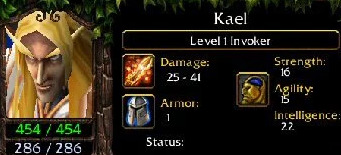
Invoker from Warcraft 3 Dota
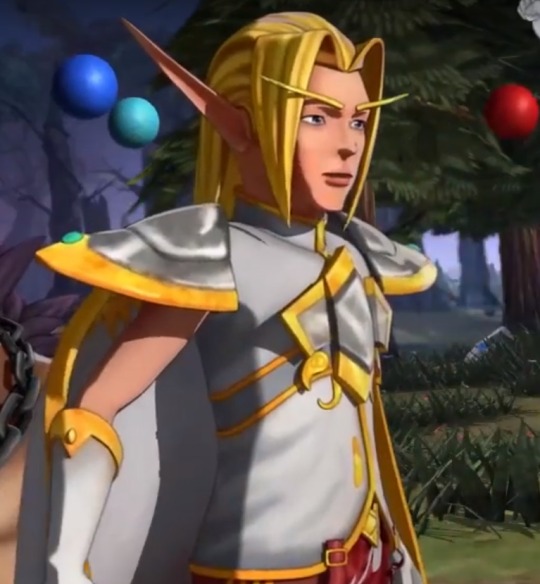
Invoker from Season One of the show

Invoker from Season Two
While this Invoker is as OOC as he can get, there’s no denying the detail that has been put into his design. For example, in Season 2 his orbs are actually faces, perhaps representing the connection of Invoker’s volatile temperament to his elemental powers.
Just as the two parts of the show are divided into a dichotomy of light and dark, there are two different depictions of Invoker in each part.
Season One Invoker
If you’ve ever played this hero, Season One will remind you of how it felt the very first time you tried him in a game. Clueless, powerless, the butt of your teammates’ jokes perhaps.
Carl first appears in episode two quoting that famous line from Shakespeare’s Hamlet. It sounds really pretentious (not that surprising for Carl), but considering that Hamlet killed someone by accident in the play, it’s also a kind of foreshadowing of what will happen later on.
So Carl is introduced as a depressed guy trying to hang himself. In a comically tragic manner, he tells his story as a former prince who lost his home, sought refuge with the Dire/Scourge but is constantly scorned for being useless as he hasn’t figured out his spells.
With a background like that, who wouldn’t be damaged for life? But CM sees him as even more vulnerable than her, and he brings out the encouraging and protective side of her. Of course, the naive part of her ignores the fact that he is a defector from the enemy side.
Carl is of course extremely grateful, having found the acceptance he’s always longed for, and one can see the beginning of a pure, somewhat platonic love between the two.
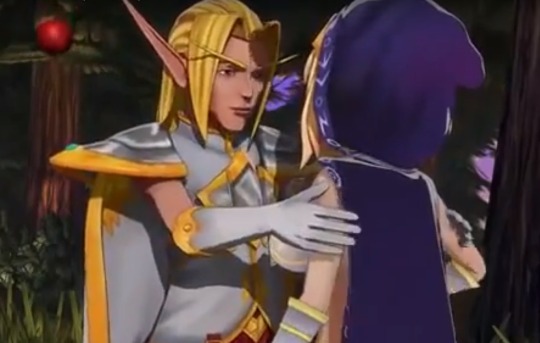
In China, Invoker/CM are almost regarded as canon pairing, with roots going back to Kael’thas/Jaina from Warcraft.
Initially, she brings out the good qualities in him, such as courage and self-sacrifice. Noob Carl is actually quite lovable, even willing to take one for the team by ‘donating’ blood to the Bloodseeker. He forges a strong friendship with the gang and they have a lot of fun fending off their one enemy in Season One.
Although he’s harmless at this point, his uselessness repeatedly emphasized by all characters, there are glimpses of his more complicated self, such as when he uses his knowledge and cunning to get the team out of trouble. More foreshadowing of who he is to become is given by the Queen of Pain, who tries in vain to warn CM about his potential for evil.
Meteoric Rise to Power
Two events serve as catalysts to the awakening of his powers. First there’s the excessively bloody whipping that Queen of Pain gives him, just because she feels like it. This happens in the middle of a team fight and in his state of desperation, it is his thoughts of CM (whose nickname is literally, Little Ice Ice) that unlocks his first skill, Ghostwalk. At the same time, the sinister side of him awakens as he turns the tables on the Queen and blinds her in one eye before burying her alive.
And then he gets punished by Doom, who’s rather high up in the hierarchy here. Doom (whom everyone calls ‘Daddy’) is furious to find out that his beloved god-daughter, his Little QuoP has been hurt. He finds out about this in an interesting manner - by devouring the jungle centaur that witnessed the incident.
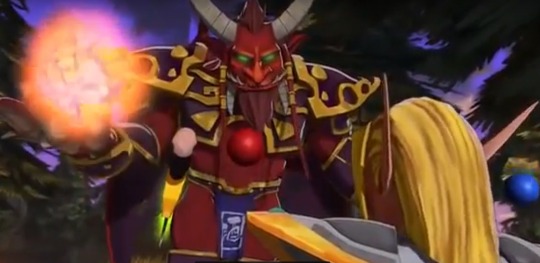
Doom: WHO ATE THE COOKIES?
Tiny, CM, etc: (keeps quiet)
Doom: Very well, I shall find out the truth (devours jungle creep).
(everyone watches on nervously)
Doom: …CARL!
Carl: Yes Daddy?
Doom: How dare you eat my cookies!
Carl: I don’t get what you’re talking about, Daddy
Doom: You’ll get THIS, you little shit.
Season Two Invoker
After being doomed and running into the forest in agony, Carl goes missing for a while. A flashback later shows Dazzle’s saved him and bandaged him up like a mummy. By chance, Windranger finds him when her Powershot arrow accidentally hits him. Probably out of guilt, she brings him home and cares for him for three months. When Ogre Magi harasses WR and sets her house on fire, Carl rises from the ashes with a complete makeover, a costume change, full mastery of magic and a marked change in personality. The change feels really abrupt and I’d have preferred something more gradual. But the writers probably wanted a striking contrast between the two seasons.
So he helps her fend off the Ogre and she falls in love with him. But he stays true to CM.
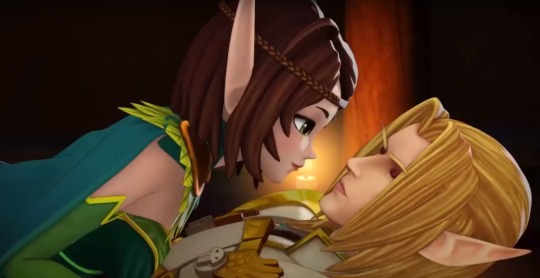
Despite what this shot in the opening theme suggests, WR doesn’t force herself on him. She’s really cool.
In Season Two, Carl’s personality becomes much more conflicted, longing to return to CM yet afraid to endanger her with Doom hot on his heels. While she thinks about him in her quiet moments, he watches over her in invisible form. The next triggering event is when the Dragon Knight beats him to rushing to CM’s rescue. He is consumed by jealousy and the fire element comes to the forefront. From then on, his emotional instability deteriorates further, and with some goading from Dazzle, he forms a plan to destroy DK with Ancient Apparition’s Ice Blast dealing the killing blow.
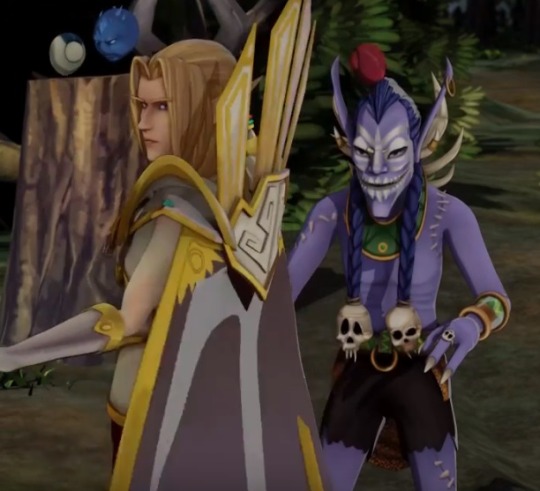
However that plan goes tragically wrong when his old friend Bristleback walks into the Sunstrike spot. One mistake leads to another, and he ends up killing QuoP as well. That confrontation between the two is one of the most dramatic scenes I’ve ever seen. When the Queen threatens to reveal his bad deeds to CM, he starts grovelling and begging her for forgiveness, but it turns out it’s all an act allowing him to get close to her for a tornado. Despite the cringeyness there is a special kind of satisfaction in seeing one’s favourite video game character display the whole range of emotions, just as it’s satisfying seeing him perform the whole shebang of spells after being abused for the first ten episodes.
Carl’s final move is one that completely breaks CM’s heart. He steals the Aegis meant for saving Bristleback’s life. However, his motivation isn’t very clear and was the topic of much debate and speculation among the Chinese fans at that time. But going by his character’s trajectory, it’s highly likely he’s doing it for self-preservation. After all, Doom’s absolutely livid that he’s killed QuoP and the Aegis is his only chance at standing against Big Daddy Doom. But the ending leaves questions unanswered. Now that he’s pissed off both sides, what’s to become of him? Is his character totally irredeemable? How will the war end? Season Three was supposed to be in the works, but never materialized.
2 notes
·
View notes
Text
Full Coverage of the Vreni Medal Services
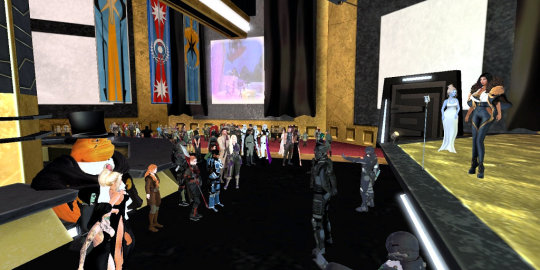
It was a festive night as Corellian celebrities, business moguls, and locals alike dressed in their finest to mingle with and to honor the men and women who risked their lives during The Vreni Crisis. Although there was an undercurrent of somberness among those gathered, there was also a sense of relief and closure. "I'm just happy that whole affair is done with...", remarked one party goer, with another stating, "Well I just think it's great that these people are getting the recognition they deserve. Some of 'em were civvies like you and me!"
The ceremony was kicked off with a speech by Councilor Zwee Keiko, transcribed here for those readers unable to attend the open event or couldn't view the live Holonet feed...
"I'm Councilor Zwee Keiko, and I want to thank you all for gathering here today, and to those watching these proceedings live on the Holonet. We've assembled here today in honor of both those brave souls who have risked their lives not just for Corellia, for an attack on one of The Five Brothers is an attack on them all, and our stalwart citizens who had the courage to brave those tortuous weeks in the captivity of the spineless Scourge. So too will we be honoring the lives lost throughout the occupation...we will be erecting a monument on Vreni Island, starting as soon as the last pebble of rubble is cleared, brandishing a plaque with the names of every individual whom The Scourge tore from us. Their names will forevermore stand tall on Corellia as they stand resolute in our hearts.
There had been a few murmurings, I remember, about our CorSec forces teaming up with outside groups in order to maintain the law and accomplish their goals. I, myself, was a vocal critic of a few of these groups, so I understand well our population's hesitancy concerning these forces. But we cannot forget that we would have failed in our mission, failed our friends and loved ones, without the aid of these courageous independent groups. From varying backgrounds they came, not for want of reward...not for self glorification, but to save Confederation lives and serve Confederation ideals. To those gallant men and women, we hope that these humble trophies we bestow upon you today can in some small way properly honor your fortitude and your bravery for your actions on Vreni Island and the extended campaign here in Coronet City.
The first group I would like to congratulate operated under Shaka the Hutt. The smallest of our forces, but many a Scourge terrorist and even the fearsome Val'Kar the Deshade would give testament to their brutal precision. Well, they would if they were still alive, that is! So precise were they in the execution of their mission, that they were able to assist the other platoons by knocking out the Scourge held power station- saving the lives of many hostages, even though they were but a handful. Regular citizens, they. Not enlisted in our military, nor CorSec, these valorous few nonetheless risked their lives so that others may live. You represent the best of our citizenry, and provide a high standard for us all to live up to.
The Scourge's strength had lay not solely on ground forces, but also in the air and orbit. Fearsome gunships were under Nec'rons command and truly would the campaign have been lost without the aid of Jen Cress, Empress of the Galactic Empire, and her skilled starship crewmen. The Empress had reached out to our government with a hand in friendship...even before the Vreni Crisis, she had set up a homeless shelter and vocational school right here in Coronet City. Her and her Empire's commitment to protecting and improving Confederation lives ended not solely with destroying enemy gunships, were it not for her evacuation craft our hostages wouldn't have made it off the beach. I can only hope that this will lead to a bright future, a friendly alliance, between our two governments.
The hostages could not have found their safety aboard the Empire's vessels were it not for the Green Jedi. The fiercest fighting during The Liberation of Vreni happened between the jedi and the bulk of the Scourge's forces on Vreni's very streets. Through waves of Scourge fighters, through insidious anti-personnel turrets these heroes waged battle against The Confederation's enemies. And still while the fighting was at its darkest, through the din of blaster fire and the smoke of mortars, these jedi stood fast in the tenets of their order: protect life. Far easier would it be to have killed all Scourge, yes, but doing the right thing is seldom easy. Thanks to the jedi, Vakira Crane lived to stand trial as had many other terrorists. Thanks to the jedi, thousands were safely ushered to rescue craft, and due mercy was given to those who had been corrupted by Scourge rhetoric.
Our heroic men and women in CorSec not only assisted the jedi during battle, but bravely rushed in through the tumult to, quite literally, save not just lives but the island itself. CorSec's bomb squad performed their duty admirably, under the worst conditions imaginable, and for that our children's children ought to be thankful. I witnessed those explosive devices firsthand, and trembled at the thought of Nec'ron using such destructive force. These CorSec officers did not bat an eye, did not flinch in the performance of their sworn duty-not on Vreni Island, not against the Scourge agent Bones- and even now, at this moment, those fearless souls continue to protect us. A testament to duty, to honor...officers, you will always have our undying thanks for all you did and for what you continue to do day after day. Officers, you are the brightest stars in Corellia's night sky.
Of course, none of this would have been possible at all without the Mandalorians providing the distraction needed for all of these groups to function. I don't need to stand here and explain what a Mandalorian is. Their efficiency and professionalism are so great that it's become a legend in and of itself. Fortunate were we that these armored men and women lent their aid to us in our time of need. The mere sight of these Mando'ade sent the whole of the Scourge into a panic so completely that this group is single-handedly responsible for capturing the detestable copkiller Noj Peesejama AND taking down the ruthlessly brutal Bofa Treat gang boss, Nenthus Rordul. Each of the groups mentioned previously would have suffered greatly, in my mind may have even failed, without these Mando'ade. They are truly, in their words, jatnese be te jatnese."
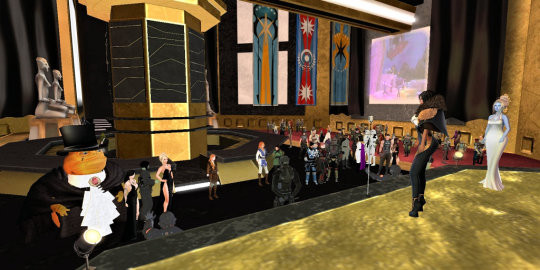
The Councilor then handed the ceremony off to CorFed diplomat Alaina Obdris and Prime Minister Victoria Scatter, who had a speech of her own...
"Thank you Councilor Zwee for the most amazing speech. I don’t think I could of say it any better. Good day Citizens of the Coreilla.. I’m so glad to have you all here today for such a special occasion. As you all know for the last couple of weeks we have been dealing with a lot of issues. This involve having Nec'ron the leader of Scourge to take control of Vreni Island. During the time of his control of the island we have lost quite few of our citizens and the once beautiful island which was Vreni was turned to a near warzone.
Yet we still managed to rescue the rest of the hostages and detain many Scourge members including this Nec'ron. I couldn't stand here and tell you about such an accomplishment without also telling you all the brave individuals that worked with helping us bring justice to this awful incident. I as your Prime Minster, The Corellia confederation and the rest of Corellia can't even say how much to thank you all. Therefore these individuals are receiving a medal as the symbol of the government's thanks for their services."
Each of the aforementioned groups and individuals received medals based on their actions during the Crisis. The Battle of Vreni Service Medal went to those who actively fought on the island during it's liberation, The Corellian Joint Service Medal to those whom served with covert activities, support roles, and the successful operation to take down Scourge agent Bones, and finally three jedi received The Corellian Gold Service award for their roles in defusing explosives at the culmination of the Sith temple takedown near the beginning of the Crisis.
Each group had a chance to say a few words in front of the audience before posing for pictures...
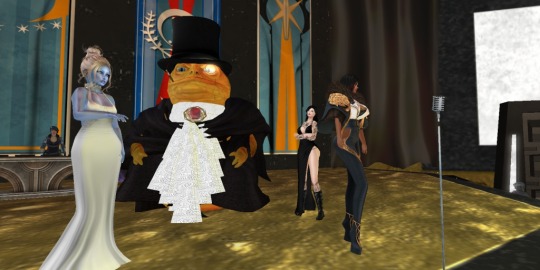
SHAKA THE HUTT: "Thank you and thank you to those who volunteered their time and risked their lives. The Baron could not join us today but I would like to tell you that 54 hostages were rescued solely by his bravery and no doubt fast talking and maybe a bottle of Whiskey or three. Thank you Prime Minister for allowing us to be of assistance."
EMPRESS JENN CRESS: "I would like to take this moment, to say a few words. To the people of Corellia, and to the people of the galaxy. First, your welcome to us has been gracious, and kind, and I thank you sincerely, the Empire thanks you, from the bottom of our hearts, We are moved by your hospitality, and your grace. We have been proud to have helped the people of Corellia. The Imperial Mission is often close to full, but we always will make room for more. To the Brave men and women who fought for our glorious Empire, I have never been prouder. Your steadfast devotion to the cause of The New Order is unwavering, and your strength is inspiring.To the people of The Galaxy, The Galactic Empire has offered it's hand in friendship, to all worlds. Not just the five brothers of Corellia, The Empire is a Galactic Empire is not mine alone, it is yours. All of yours. Every living soul in the galaxy. It exists for you. The Empire began nearly 300 years ago, a dream of a united galaxy. Each world standing strong, represented by strong hands, secure, and at peace. Each united in harmony with each other, a Constellation a galaxy wide. A dream of many peoples, as one. One Empire, under a New Order. An Order of security, of prosperity, of progress. There have been mistakes, in the past, and many things have been done, unspeakable. There have been ups and downs, victories, and defeats, Interregnums, and usurpations by those who did not have the best interest of the galaxy in their hearts. But those days are in the past. And the Empire looks ever forward. People of Corellia, People of the galaxy. Today, in the spirit of unity that saved the souls of Vreni island from the scourge that threatened the mores of civilization itself, I ask you, when Civilization itself is threatened. When the very foundations of what makes us human is challenged by evil and disorder. To whom may you safely turn to protect you, to shepherd you, to join hands with you as beacons of light in a galaxy all too often clouded by darkness? You know ,in your hearts already the answer. I know this to be true. Remember. The Empire began with the salvation of the Old Republic, We are it's torch carried into tomorrow. And when it is lit across every world once more, All Stars shall shine as One."
Perhaps the most flamboyant acceptance speech came from one of the Mandalorians honored, one EKUWA SKIRATA, who gifted the crowd with a bit of flexing and holding her medal case aloft: "Soron bal Min, Ni narir bic! Wooooohooo!", which sent some much needed levity throughout the crowd. Before tossing the microphone back to our Prime Minister, she added: "I aint got no big speech but to Noj Peesejama, if you're watching this from your cell, I told you I was going bust your ass again and I diiiiiiid!" Another member of the Mandalorian group also had a few choice words to say, though they certainly do not reflect the opinions of this editorial staff: "You are all soulless Aruetii so I will make this short and easy to understand, abandon your silly aruetii ways and join the mando'ade, or at the very least make sure if you are going to be weak to have the foes be strong if we are going to be fighting them for you so we might have fun fights!"
Speaking on behalf of CorSec, Sergeant SHEPHERD: "Good evening, My name Is Sergeant Shepherd. I want to first extend my gratitude towards the Mandalorians given I was apart of their team for the Island siege. However, I'd like to remind everyone here...That you're guests, Under the banner of temporary unity. Even if that means for a few hours. I request you all act cordially with one another through the rest of the event. On that note, I'd like to extend my thanks to the factors that brought us here, tonight, Without their wicked intentions, without their plans for the worst...we may not be here tonight, so I'd like to thank all of you, for being here to support one another....Thank you."
The Green Jedi, represented by one TAAJ OUSAN, accepted their honors and medals with the sort of humility we've come to expect and declined a chance on the microphone.
Many awardees were unable to attend the event, but we're told that they haven't been forgotten and will be duly receiving their medals by other means. With that the ceremony ended, though many partygoers still lingered to mingle, dance, and enjoy the buffet spread. In all, a satisfying if not jubilant ending to a dark chapter in our Confederation's history.
(( If you didn't get to attend the ceremony but participated in the Battle of Vreni or the Raid on the Scourge Compound in Coronet you can receive your mesh representation of your award from Sҽɾα Rυɳσ A.K.A. Mιɳxყ (Sera Swords) . If you have any problems getting in touch with her, can poke me. As some of you are aware there was a falling out a half a year ago with some of the co-owners of the sim. This included the one who controls the LRS server. To cut a long story short they've deleted all our item tables, and locked our people out of the server so it's very difficult to maintain/edit/adjust/etc. Due to this LRS is seen as a bit of a dead end. Why now? IDK. So we're going to hold off on creating anything new for LRS as we prepare to switch to another combat system. Hence why we didn't do them in LRS. ))
0 notes
Text
infernal shiv-em-up The Suffering delivered lurid jailhouse shlock • Eurogamer.net
No-one likes being cooped up: that’s why incarceration is such a time-honoured punishment, from medieval oubliettes to the 18th-century panopticon. But when you first meet The Suffering’s convict anti-hero Torque – a badass but slyly ironic name considering his taciturn nature – he barely seems to spend any time confined in an actual slammer, despite being jailed for murdering his wife and two kids.
That’s because shortly after Torque is frog-marched onto Death Row by a squad of caricatured prison guards, all hell literally breaks loose. This brawny brawler with Wolverine mutton chops is thus abruptly free to run amok through a fetid prison facility sited on a bleak island miles off the coast of Maryland. Navigating via feeble flashlight through the oppressive corridors of Abbott State Penitentiary requires guts and gumption, not least because Torque is tortured by unpredictable visions of his violent past accompanied by the unsettling clamour of a glass harmonium, familiar from dozens of horror movies as sonic shorthand for mental distress.
Is it really freedom if you’re surrounded by infernal monsters, most of whom seem to be the offspring of Soulcalibur’s circus-tumbling leather-daddy Voldo? You can’t say you weren’t warned. The Suffering – developed by Surreal Software and published in 2004 by Double-A Team all-stars Midway Games – did not just signal its bellicose intent with that scourging title. There were other clanging clues. The cover art, at least in the UK, featured the disturbing image of an anonymous and clearly doomed convict frantically reaching out through prison bars while an ominous hell-beast loomed behind them.
This was survival horror that refreshingly played by prison rules, where only the strongest and most ruthless would survive. From the moment Torque wields his first improvised shiv, he is at least as deadly as the hellish creatures he faces. Instead of the sneak-and-retreat tactics of Silent Hill and early Resident Evil instalments, this was a psychological chiller that encouraged proactive combat. Rather than withholding ammo, the game soon gifted you a chattering old-school tommy gun (although it also pitted you against a chunky behemoth hefting a cluster of rifle barrels on its powerful back like a saggy set of bagpipes).
As well as scooping up tons of useful ordnance, Torque also possessed the unnatural and unexplained ability to hulk out into a steroidal cenobite at least as bloodthirsty and nightmarish as his opponents. This bizarro duality – plus the ability to toggle between first- and third-person viewpoints at will – added some breadth to what was a fairly narrow campaign, tasking the player with carving a singular path across and under the hardscrabble island to untangle its accursed history of decrepit landmarks, including an abandoned military base, a grand but gloomy asylum and a bustling graveyard.
Appropriately for a game about justice, there was also a morality system at play under the surface: if Torque assisted fellow inmates and panicking corrections officers he was more likely to unlock the happier of three endings. The more immediate pleasures, though, came from mowing down enemies with dual revolvers that sounded like goddamn cannons going off.
The Suffering seemed to beam in from the same lurid noir universe as Max Payne, where burdened sinners exorcised their personal demons via bursts of cathartic ultraviolence while popping illicit pill bottles that rattled like Tic Tacs. Over fifteen years later, it still feels like a genuine B-movie, a gnarly gumbo of grubby violence and muddy graphics. A 2020 remake or remaster that sorted out the queasy aesthetic would be missing the point. It was that visual and moral quagmire that made The Suffering such a breakout hit.
from EnterGamingXP https://entergamingxp.com/2020/04/infernal-shiv-em-up-the-suffering-delivered-lurid-jailhouse-shlock-%e2%80%a2-eurogamer-net/?utm_source=rss&utm_medium=rss&utm_campaign=infernal-shiv-em-up-the-suffering-delivered-lurid-jailhouse-shlock-%25e2%2580%25a2-eurogamer-net
0 notes
Link
No-one likes being cooped up: that's why incarceration is such a time-honoured punishment, from medieval oubliettes to the 18th-century panopticon. But when you first meet The Suffering's convict anti-hero Torque - a badass but slyly ironic name considering his taciturn nature - he barely seems to spend any time confined in an actual slammer, despite being jailed for murdering his wife and two kids.
That's because shortly after Torque is frog-marched onto Death Row by a squad of caricatured prison guards, all hell literally breaks loose. This brawny brawler with Wolverine mutton chops is thus abruptly free to run amok through a fetid prison facility sited on a bleak island miles off the coast of Maryland. Navigating via feeble flashlight through the oppressive corridors of Abbott State Penitentiary requires guts and gumption, not least because Torque is tortured by unpredictable visions of his violent past accompanied by the unsettling clamour of a glass harmonium, familiar from dozens of horror movies as sonic shorthand for mental distress.
Is it really freedom if you're surrounded by infernal monsters, most of whom seem to be the offspring of Soulcalibur's circus-tumbling leather-daddy Voldo? You can't say you weren't warned. The Suffering - developed by Surreal Software and published in 2004 by Double-A Team all-stars Midway Games - did not just signal its bellicose intent with that scourging title. There were other clanging clues. The cover art, at least in the UK, featured the disturbing image of an anonymous and clearly doomed convict frantically reaching out through prison bars while an ominous hell-beast loomed behind them.
Read more
0 notes